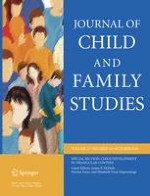19-06-2018 | Review Paper
Strategies to Engage Underrepresented Parents in Child Intervention Services: A Review of Effectiveness and Co-occurring Use
Gepubliceerd in: Journal of Child and Family Studies | Uitgave 10/2018
Log in om toegang te krijgenAbstract
The purpose of this review was to estimate the impact of parent engagement strategies tested with underrepresented families of young children with social, emotional, or behavioral disorders, and describe the combinations in which these strategies are commonly used together. We conducted a systematic review using the PracticeWise Engagement Coding System to identify which strategies had the strongest empirical support for engaging underrepresented (i.e., minority race or ethnicity, or low income) families receiving psychosocial services for their children. Social network analyses were used to identify the frequency of strategy use and how strategies were combined to engage underrepresented families. Linear regression was used to estimate the impact of each strategy on parent engagement, using attrition as a proxy for non-engagement. Thirty-five studies met inclusion criteria. Parent attrition was predicted by larger sample sizes, lower maternal education, interventions that were more community or home-based, less therapist monitoring, positive reinforcement from therapists, and more pairing families with peers. Social network analyses suggested that more effective strategies were more frequently implemented alone and less effective strategies were commonly combined with each other. Our findings suggest that researchers and practitioners require guidance in selecting engagement strategies to reduce attrition of underrepresented families in treatment. Although we identified promising strategies for improving parent engagement in treatment for underrepresented children with social, emotional, or behavioral disorders, the frequent combining of engagement strategies in research means that there is little data on the independent effects of interventions to increase parent engagement for this population.
